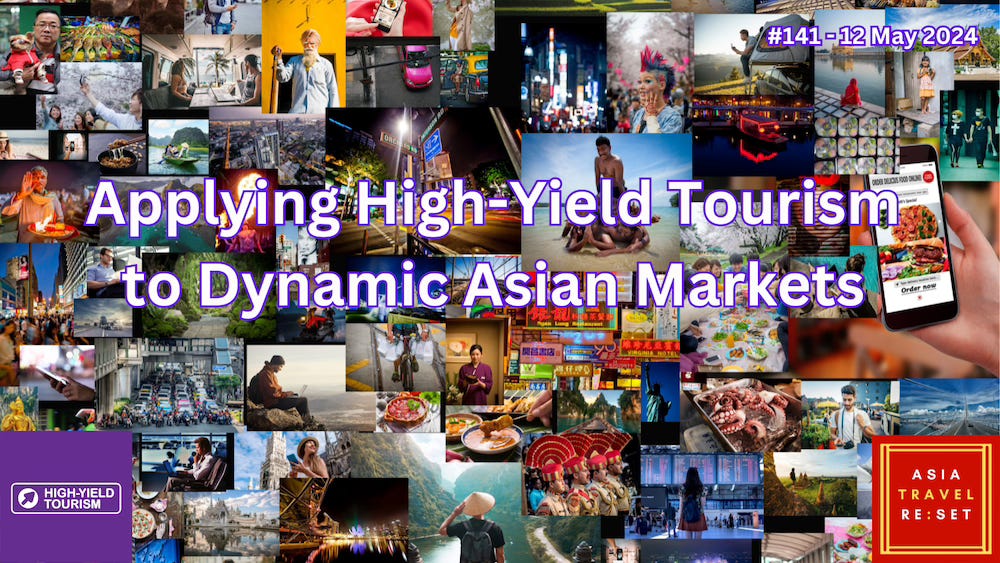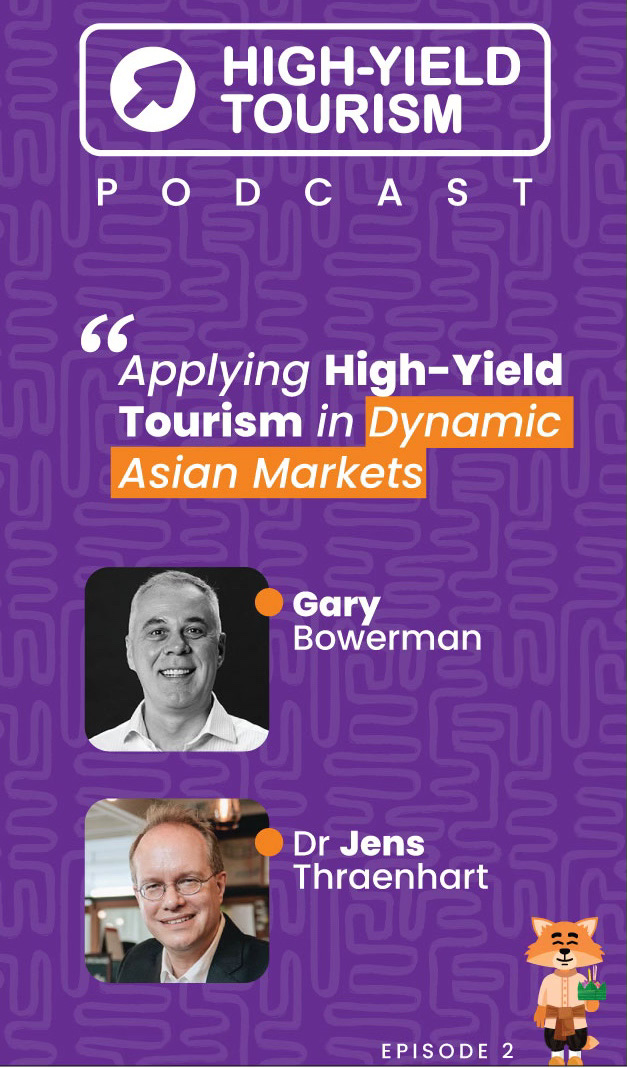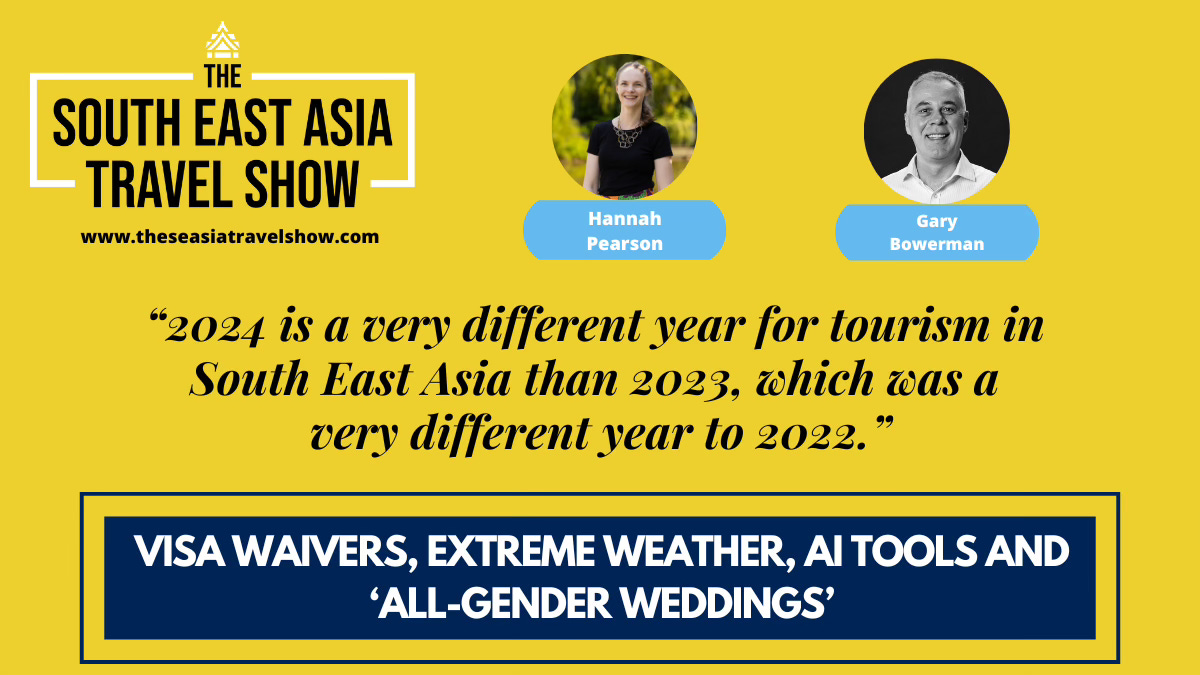Issue #141 - Applying High-Yield Tourism to Dynamic Asian Markets
Insights from China, Japan, Thailand, Singapore, South Korea & Mongolia.
Welcome to issue 141 of Asia Travel Re:Set.
Bags are packed, I’m bound for Barcelona and Madrid!
Meantime, competition for tourists across Asia Pacific is fierce.
New strategies are being rolled out to take destinations through the unfolding era - with Singapore unveiling its Tourism 2040 plan this week.
So, let’s follow that train of thought…
Thanks for checking-in.
- “IN THE NEWS”
- Applying High-Yield Tourism to Dynamic Asian Markets
Insights from China, Japan, Thailand, Singapore, South Korea & Mongolia.
- Visa Waivers, Extreme Weather, AI Tools & ‘All-Gender Weddings’
Assessing the big-ticket issues in South East Asia so far in 2024.
“IN THE NEWS”
Am heading to Barcelona this week to speak to a diverse travel industry audience at Worldline Rise Travel 2024. I’ll be presenting on Asia Pacific’s Hot Travel Trends: Why They Matter for Global Travel & Tourism. More details in the next issue…
Applying High-Yield Tourism in Dynamic Asian Markets
Today’s issue recaps this week’s Applying High-Yield Tourism in Dynamic Asian Markets podcast, with 5 key points - and plenty of gaps for you to draw your own conclusions and listen to the show!
1) “Tourism strategy for the future is coming from the very top, from political leaders.”
Tourism strategy is built into government trade and investment policy in much of the region. Increasingly, national leaders are usurping Tourism Ministers to get the messaging out. Thailand’s Prime Minister Srettha Thavisin appeared at ITB Berlin in March to present the new ‘Thai Soft Powers” campaign, which incorporates tourism. Mongolian Prime Minister L. Oyun-Erdene launched the Go Mongolia campaign in South Korea. The two governments are working on tourism promotion, film making and infrastructure development projects in Mongolia. Meanwhile, Friday’s launch of Singapore’s Tourism 2040 strategy was delivered by Grace Fu, Minister of Trade Relations, as the city-state prepares for Wednesday’s Prime Ministerial handover.
“Wherever travel and tourism goes in future in the Eastern Hemisphere it is going to be driven by governments, it is going to be driven by political leaders and it is going to be driven by investment.”
2) “Travellers across Asia Pacific are living out their post-Covid lifestyle passions when they travel domestically and internationally.”
Destinations and travel brands are seeking to keep pace with fast-changing lifestyle trends and patterns of demand. With visitor numbers rising, destinations face new challenges as recovery transitions to growth. Such challenges are especially evident during the high-volume public holiday periods that drive the region’s tourism sector. Many of the re-growth issues in Asia Pacific are coalescing in Japan, where the scale of its inbound recovery has been remarkable. The same pre-Covid impacts on communities and the environment are resurfacing. Ditto in Thailand, which has already attracted 12.6 million visitors in 2024 - up 39% on the same 2023 period.
Listen to Episode 2 of the High-Yield Tourism Podcast: Applying High-Yield Tourism in Dynamic Asian Markets:
And, check out our website
3) “You don’t want to buy something in a destination that when you turn it over has a ‘Made in China’ sticker on it.”
The concept of Geographic Indications (GI) started in Europe as a certification process to verify the authenticity and origin of foods. It’s now gaining traction across Asia, which is moving ahead of Europe in terms of GI registrations because of the addition of handicrafts - which are fundamental to shopping and purchasing local souvenirs. “When you look at South Korea, which has developed a foundation around K-pop and K-culture and building branding and tourism around it, the authenticity and the trust that comes with it are vital.” Trademarking in tourism enables destinations to really play to their own strengths. Watch this space.
4) “China is the most multi-segmented consumer market in the world.”
China is often defined outside the country as a “mass tourism market.” In many ways it is, because of its volumes, but it is also highly complex. How do you attract and engage its high-yield travellers who are very hard to find and to please. Consumer trends and young people’s perceptions around brands change extremely quickly. The overlay of a highly dynamic consumer culture and unique social networks makes travel and lifestyle indivisible concepts. Travel, whether domestically and/or internationally, is an integral part of a modern lifestyle. Tourism is not marketed as its own separate industry, and there is a different timeline for domestic tourism marketing in China that is not framed by long-duration campaigns.
5) “Does backpacking in Asia fit into the high-yield tourism model?
Yes. South East Asia is the spiritual home of backpacking, a standalone but easily dismissed genre of travel. Thirty years ago, regional tourism boards embraced backpackers as a vital component of visitor markets. As the industry has changed, and domestic and intra-regional travel markets have enlarged, backpacking got pushed to the margins. Yet, backpackers stay longer, travel widely, spend in local communities and use local transport and tour providers. They are voracious social media users, which builds advocacy for a destination. Even so, backpacking sits outside conventional tourism thinking, which has moved more upscale across the region.
Visa Waivers, Extreme Weather, AI Tools & ‘All-Gender Weddings’
On this week’s The South East Asia Travel Show, we assess the region’s progress so far in 2024 on some big-ticket issues in tourism. En route, we look at whether visa waivers are a competitive tourism battleground, and evolving patterns in Weekend vs Weekday travel. Plus, are we seeing any progress to bridge the Say-Do sustainable travel gap, and is there any evidence AI tools are improving travel planning?
And we track Thailand’s timeline to becoming the first ASEAN nation to legalise same-sex weddings. When will it happen, and how might it influence travel trends?
Listen to Visa Waivers, Extreme Weather, AI Tools & ‘All-Gender Weddings’, here:
Or search for The South East Asia Travel Show on any podcast platform
And, that’s a wrap for Issue 141.
The Asia Travel Re:Set newsletter is taking a short vacation. Back on 26 May.
Until then, find me at LinkedIn and The South East Asia Travel Show
Happy travels,
Gary







